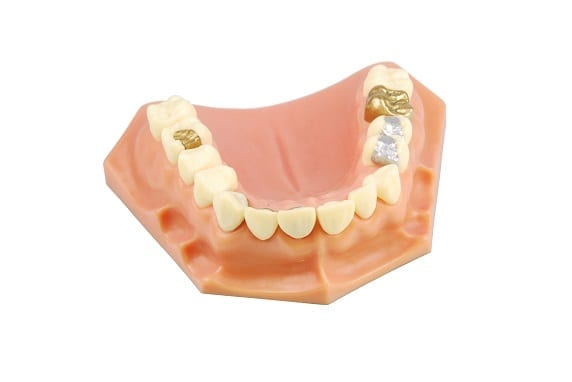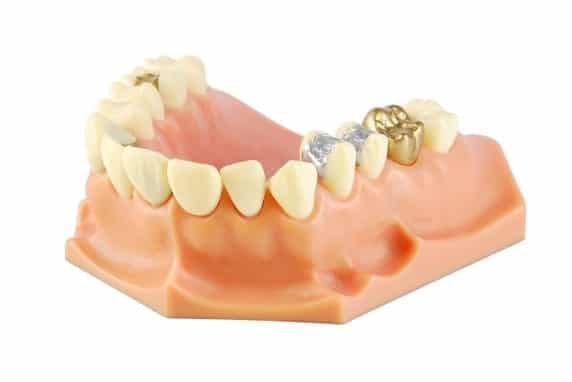Dental fillings are used to treat dental caries, which are more popularly referred to as tooth decay and/or cavities. These cavities are caused by acid waste products from bacteria in your mouth that feed on sugars and starch. They’re the reason why you should watch your diet and cut down on sugary and starchy food is because of tooth decay risk (among many other complications).
At any rate, one of the primary ways your dentist can go about treating your cavity is by removing the decayed portions of it and then filling it up with material known as dental or tooth filling. It’s made of different materials depending on the extent of the decay, what type of tooth is affected, and whether the tooth is visible or not when you smile.
What Is a Dental Filling?
Dental filling is used to repair teeth with cavities because of oral acidity. Fillings like cement or asphalt used to fill in potholes and unevenness in the road. They’re also dependable when it comes to fixing teeth that have been worn down from misuse or abuse, such as eating cracker nuts, bruxism or tooth grinding, and nail biting. Your dentist will ultimately decide which type of filling is best suited for your specific situation or dental issue. He can also suggest putting on crowns, bridges, or veneers if fillings aren’t enough to save your tooth.
In order to determine the type of filling that works best for you, your dentist will need to first determine the extent of the decay, the location of the decay (molars versus incisors and canines), the type and cost of the filling material that works best for you, the extensiveness of your insurance coverage, and the type of problem that requires fixing (a broken tooth versus cavities). Just remember that fillings can’t save a tooth with a cavity so big that barely any tooth enamel or dentin is left.
What Steps Are Involved in Filling a Tooth?

Here are the steps involved in filling in a tooth with a tooth filling.
- Anesthesia: The area will have to be numbed first care of anesthesia. The dentist will first inject local anesthetic into your gum via injection to make the area around your tooth insensitive to pain as the affected tooth is filled.
- Drilling: Next, the dentist will typically use a drill to remove the decayed material of the tooth since the filling won’t be able to stick to the tooth if it’s on compromised or non-solid “ground”. He might instead use a laser or abrasion instrument as well.
- Training: Which instrument is used to prep your tooth for being filled with depend on the individual dentist’s training or expertise, comfort level in using a particular dental tool, and the investment on the particular piece of equipment. The extent and location of the decay can also affect such decisions.
- Probing and Testing: Afterwards, your dentist should test or probe the affected tooth and its cavity or damage to know if all the decayed material has been removed. After only the healthy parts of the tooth are left will your dental healthcare professional prepare the missing space for filling purposes.
- Cleanup: The first thing the dentist will do is clean up the space for the filling. It’s for the sake of removing bacteria and remaining debris from the cavity or the cracks of the damaged tooth. You’ll be asked to spit that out to prevent bacteria from infecting your digestive system or tainting your bloodstream.
- Liner: If the tooth decay has reached all the way to the root, the nerve must be protected to prevent inflammation. In such instances, the dentist might put in liner made of composite resin or glass ionomer that safeguards the nerve from contact. If it’s been inflamed, then a root canal procedure might be in order and the tooth might be shaved off to put in a crown.
- Filling: After the area has been suitably roughed up and cleaned, then the filling is put into your tooth. Sometimes, a light is shone on the filling to make it harder faster, but it depends on the material. You will be made to bite down on sanding paper to grind the filling out. The dentist will polish and finish the filling after it’s been placed unto your tooth.
There are also additional steps done to finish up the procedure if the dentist is putting in tooth-colored fillings unto your teeth.
- Multilayered Filling Application: The tooth-colored material is applied in layers after removal of the decayed parts of your tooth and cleanup of the area. This ensures that the filling won’t pop out as easily.
- Special Light Curing: The aforementioned special light is shone unto the composite resin in order to harden or cure the filling after every layer is applied. So it’s application then light shining again and again.
- Shaping Up The Composite Resin Filling: After the whole process of multilayered resin is finally done, the dentist will use his tools to manipulate the composite material to the right shape.
- Trim Off Excess Material: A drill or sandpaper might be used to trim off excess material. You’ll be asked to bite down and determine if your bite has been altered or not before the filling is shaved off thusly.
- Polishing and Finishing Up: The final restoration process involves mostly polishing the tooth-colored filling until it matches the rest of the tooth’s enamel and is practically invisible when all is said and done.
What Types of Filling Materials Are Available?

There are multiple dental filling types available for you to choose from. Teeth can be filled with silver amalgam or mercury mixed with various metals, gold, porcelain, or composite resin filling. There are also materials such as the one that contains glass particles known as glass ionomer—this one is applied and used in a similar way as composite resin fillings.
- Cast Gold Fillings: It’s a filling made of gold and has multiple advantages. It’s been in use for dentistry for 4,000 years and it’s one of the earliest means of filling in your teeth.
- Pros: Gold fillings are durable and can last for 10 to 15 years. It usually lasts longer than that, actually. It doesn’t corrode. It’s strong enough to withstand your chewing forces for good measure. On a strictly subjective sense, some patients find the aesthetics of gold more eye pleasing than silver amalgam.
- Cons: Naturally, gold fillings are expensive even if only a small amount of gold is used. It can cost up to 10 times higher than something like amalgam or composite resin. It also requires more than two office visits to get properly applied. Rarely, galvanic shock might happen if you place gold fillings next to silver amalgam fillings.
Galvanic shock is when a sharp pain happens to your teeth due to the close proximity of silver amalgam and gold fillings. These two materials interact with saliva in a way that produces electric current. Also, some patients see gold fillings and other colored fillings as too obvious and displeasing to the eye, preferring something that matches tooth color
- Silver Fillings (Amalgams): Amalgam is made up of not only of silver but an amalgam of materials. Mercury is the base material used to mix copper, zinc, tin, and silver together to form this familiar filling that has gone down the wayside due to concerns regarding mercury poisoning.
- Pros: Amalgam is about as durable as gold and can last 10 to 15 years or even a lifetime. It outlasts composite fillings more often than not. It’s strong enough to resist the bite and chewing forces of your molars. It’s also less expensive than composite fillings and definitely gold fillings. It’s probably the cheapest option available. It’s preferably used for back teeth rather than front teeth due to its strength and durability.
- Cons: Many patients dislike the aesthetics of silver fillings and how it doesn’t blend in with the color of natural teeth. This is why it’s usually placed at the back teeth or molars, which aren’t visible when you smile. Additionally, to place these fillings, the healthy parts of the tooth must be removed and destroyed to allow the amalgam to get a better grip on the hole or crack of the tooth.
Amalgam fillings can make the surrounding tooth become discolored, making it get a grayish or ashen hue. Cracks and fractures can also occur due to amalgam materials. Its presence can induce a wider degree of contraction and expansion that further destroys the tooth, leading to a higher incidence of tooth fracturing or cracking.
About 1% of patients are allergic to the mercury found in amalgam. What’s more, the mercury in amalgam releases low levels of mercury into your system in the form of vapor that can be inhaled and absorbed into your lungs. High levels of mercury can affect your kidneys and brain. However, this filling is still FDA-approved for use by children 6 years and above and adults. In turn, there are dentists who now specialize in amalgam filling removal.
- Tooth-Colored Composites: A composite resin material that can be reshaped and cured with a special light is also available for use in filling up the gaps and holes in your teeth while blending in with the rest of the tooth.
- Pros: Composite fillings closely match the color and shade of natural teeth. They’re particularly useful for use with visible parts of the teeth, such as your incisors, canines, and your first few molars. What’s more, they’re capable of chemically bonding to the tooth structure, which provides additional grip support that you won’t get from gold and silver fillings. It’ also known for its versatility.
In other words, these fillings can be used to repair worn, broken, or chipped teeth on top of being used as filling material for tooth decay and cavities. It also spares your tooth from extensive destruction because less enamel and dentin needs to be removed in comparison to silver or gold fillings. When prepping for this filling, mostly the decayed portions of the tooth require removal.
- Cons: Composite fillings wear out easier than amalgam. They probably won’t last 10-15 years—more like 5 years or sooner depending on the severity of the decay. They also break easier under the pressure of biting and chewing when you eat. If you regularly bite your fingernails or eat cracker nuts, these fillings are likelier to breakdown.
Larger cavities will usually make this filling pop out, unable to grip or bond with the rest of the tooth. As for chair time or the length of the dental visit, it typically lasts 20 minutes longer than placing amalgam fillings. This is because composite resin is applied one layer after another, with each layer cured with a special light. It’s more fragile than other filling types in exchange for its superior aesthetics and versatility.
Also, additional visits might be called for if you’re putting in inlays or onlays instead. This filing is also best used with most of the tooth intact because it tends to chip apart depending on the location. It can also chip apart the tooth itself. It also costs twice as much as amalgam fillings more often than not. Modern composite resin fillings have improved enough to allow their use for molars but they still have an average lifespan of 5 years.
Other Filling Types

Additionally, there are other types of tooth-colored fillings available aside from composite resin fillings. They include ceramic fillings and glass ionomer fillings.
- Ceramics: Ceramic tooth-colored fillings are made of porcelain. They’re known to resist staining compared to resin. However, they’re also quite abrasive. Then again, this material is capable of lasting for up to 15 years like colored fillings, but it can also get as expensive as gold fillings to boot.
- Glass Ionomer: This filling type is made of a specific type of glass and acrylic. It’s usually applied as a below-the-gumline type of filling in young children. It still requires drilling to be applied properly, though. It’s a filling that releases fluoride (instead of mercury vapors) unto the teeth, which then helps protect it from additional decay now that the cavity has reached the area of the tooth root.
In terms of shortcomings, glass ionomer is more fragile than even composite resin filings. It’s also more prone to fracturing as well as wear-and-tear. Its lifespan is about 5 years or similar to that of composite tooth-colored fillings. It should only be placed in appropriate areas and used in the right situations for the best results. It’s about equal to composites in every other area aside from durability.
In Summary
When it comes to treating cavities, the dentist will first remove the decayed portion of the tooth before putting in tooth fillings. This is because without decay removal, the filling will have a harder time sticking on the surface and further decay could occur on the already compromised part of the enamel or dentin, resulting in the dislodgement of the filling when push comes to shove. Regardless, fillings are what dentists primarily used to repair broken, cracked, or holey teeth.
Thantakit International Dental Center is Thailand’s longest established dental center. Situated in Bangkok, our clinic is renowned across the world as a destination for world-class dentistry, with most of our patients flying to us from Australia.
Please contact us today and get a FREE dental consultation.












